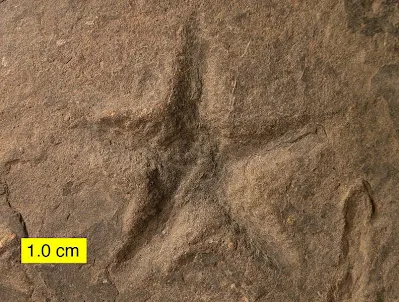Trace Fossils Types and Importance
What are Trace Fossils
Trace fossils, also known as ichnofossils, are fossilized evidence of past life's activities and behaviors, rather than the actual remains of the organisms themselves. Unlike body fossils, which preserve the bones, shells, or other hard parts of an organism, trace fossils offer a glimpse into the behavior and movement of ancient life forms.
Trace fossils may be impressions made on the substrate by an organism: for example, burrows, borings (bioerosion), urolites (erosion caused by evacuation of liquid wastes), footprints and feeding marks, and root cavities.
The term in its broadest sense also includes the remains of other organic material produced by an organism — for example coprolites (fossilized droppings) or chemical markers — or sedimentological structures produced by biological means - for example, stromatolites. Trace fossils contrast with body fossils, which are the fossilized remains of parts of organisms' bodies, usually altered by later chemical activity or mineralization, for example those produced by empty shells rolling along the sea floor, are not produced through the behaviour of an organism and not considered trace fossils.
The study of trace fossils is called ichnology, and it is a valuable tool for paleontologists who are trying to understand the behavior and ecology of extinct organisms. Trace fossils can be found in a variety of environments, including marine, terrestrial, and freshwater settings. They are especially important in helping scientists understand the behavior of soft-bodied organisms that would not otherwise be preserved in the fossil record.
 |
Dinosaur footprint in the Lower Jurassic Moenave Formation
at the St. George Dinosaur Discovery Site at Johnson Farm, southwestern Utah |
Types of trace fossils
Burrows
These are tunnels or tubes created by organisms as they move through sediment or soil. Burrows can belong to various organisms, including worms, insects, or even small vertebrates. Fossilized burrows reveal the burrowing habits of organisms, helping scientists understand their behavior, habitat preferences, and even predator-prey interactions.
Tracks and Footprints
Impressions left by organisms as they move across sediment or soft surfaces. These can include dinosaur tracks, bird footprints, or trails left by other animals. These are some of the most recognizable trace fossils, offering clues about the size, gait, and even speed of the animal that made them. Dinosaur footprints are particularly famous examples, providing valuable information about these long-gone giants. They can tell us about the animal's speed, gait, and even social behavior.
Nests
Evidence of nests or other structures built by organisms for breeding or shelter. These can include the nests of birds, reptiles, or even some mammals.
Coprolites
Fossilized feces, also known as coprolites, can offer clues about the diet of the organism that produced them. They may even contain preserved remains of parasites or prey, providing a glimpse into the food chain of the past.
Borings
Holes or tunnels drilled into hard substrates by organisms like mollusks, sponges, or wood-boring organisms. They can provide insights into the feeding ecology and interactions between different organisms.
Gastroliths
Smooth, polished stones found in the stomach region of some fossilized vertebrates, indicating their use for grinding food. They may even contain preserved remains of parasites or prey, providing a glimpse into the food chain of the past.
Feeding Traces
Marks left by organisms as they feed on other organisms or organic material. These can include bite marks, scrape marks, or other signs of predation. These are marks left by an animal as it grazes, feeds, or digs for food. They can reveal information about the animal's feeding habits and the types of food it ate.
Resting Traces
Indications of areas where organisms rested, such as impressions left by the body or imprints of body parts.
 |
| (sea star trace fossil) from the Devonian of northeastern Ohio. It appears at first to be an external mold of the body, but the sediment piled between the rays shows that it is a burrow. |
Trace fossils are essential in paleontology because they provide a window into the behavior and activities of ancient life forms, complementing the information obtained from body fossils. By studying trace fossils, scientists can reconstruct the paleoenvironments, ecological interactions, and the overall biodiversity of past ecosystems.


%20(1).webp)






